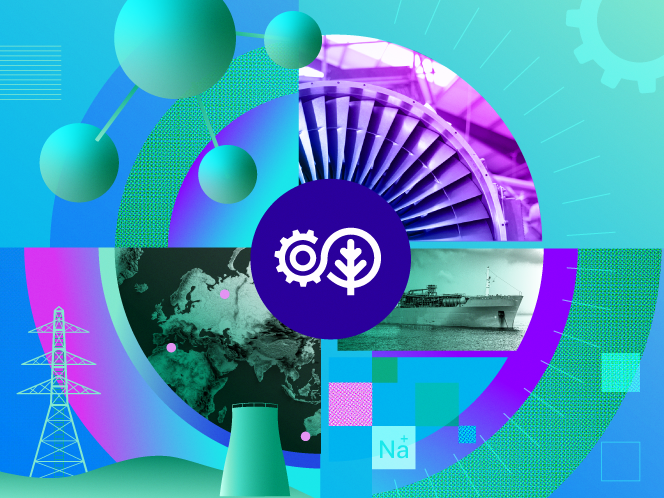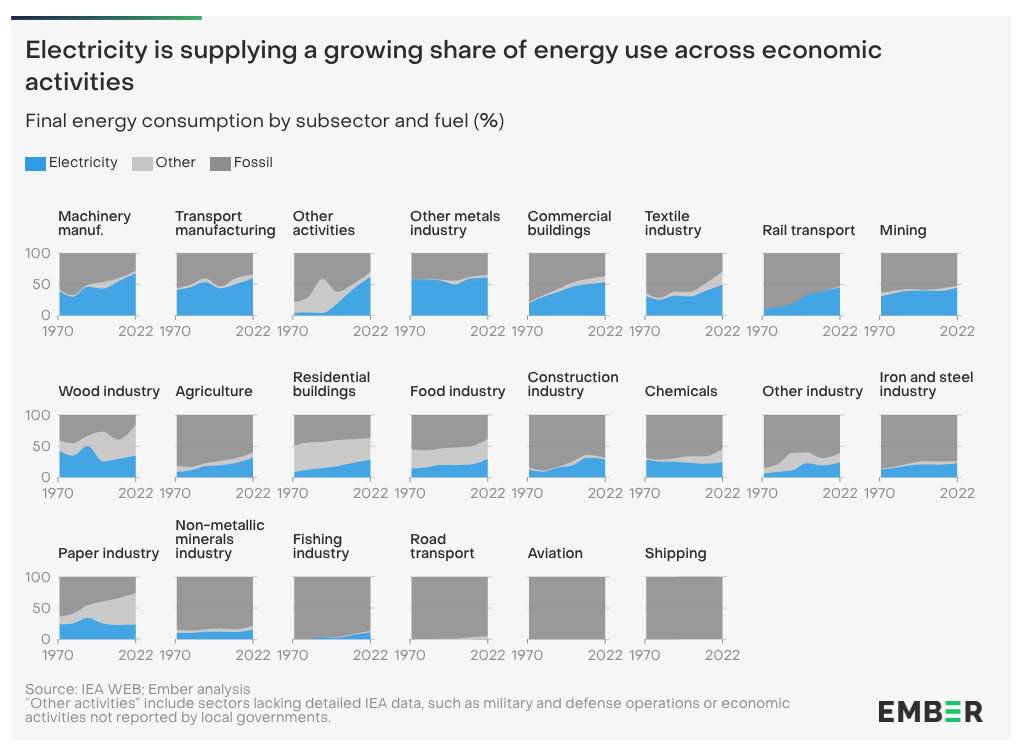The future of energy: a roundup
Posted: August 05, 2025

Every part of the industrial sector remains entangled with fossil fuels in ways both obvious and hidden. They directly power the engines in planes, cargo ships, cars and trucks. They fire the blast furnaces that make steel and iron, heat both our homes and businesses as well as the kilns that produce cement. They serve as both the energy source and raw materials for the industrial chemical reactions used to create everything from plastics to carpeting, fabrics, fertilizers and pharmaceuticals.
A major challenge for the world’s energy transition is that transportation and certain industrial processes—particularly those that require high heat or pressure—tend to be hard to decarbonize. Electrification has grown across nearly every industry since the 1970s but remains overshadowed by fossil fuels. Electricity still accounts for far less than 50% of energy consumption in most industries. And industries around the world are struggling to find suitable renewable energy sources for processes that can't easily be electrified.
Our Industrial Life
Get your bi-weekly newsletter sharing fresh perspectives on complicated issues, new technology, and open questions shaping our industrial world.

Source: Ember
Roughly 60% of global electricity generation also relies on fossil fuels. And across much of the world, the single largest source of electricity generation still comes from coal. Until 100% of electricity comes from renewable sources, every industry that flips a switch or plugs in a machine will continue to be indirectly dependent on coal, oil or gas. Even if we were able to electrify all the industrial processes mentioned above (in addition to the ones not mentioned), we would still face the major hurdle of transitioning the power grid to run entirely on renewables.
To fully achieve the energy transition, the world will have to find alternative fuels to power industrial applications while simultaneously transitioning global power grids to run on renewably generated electricity. Neither will be easy. And both will require coordination and participation from nearly every industry. But there is hope on both fronts.
The promise and drawbacks of hydrogen
In the past year, we’ve written stories about how hydrogen is being considered as an alternative source of fuel in several industrial applications that are difficult to electrify. In the not-too-distant-future, we might see hydrogen-powered planes, ships and trucks, as well as hydrogen-based steel, iron and even whiskey production.
But hydrogen is not always the straightforward green alternative that it’s made out to be and scaling it to be a global fuel source presents many challenges.
First, pure hydrogen needs to come from somewhere. Today, most hydrogen comes from breaking up hydrocarbons—which releases CO2 as a byproduct. Fortunately, there’s a whole rainbow’s worth of different strategies for isolating hydrogen that don’t result in direct carbon emissions—including pulling it straight out of the ground. Of these methods, “green” hydrogen—whereby renewable electricity is used to split water molecules into hydrogen and oxygen—is the most well-known.
A second problem is that even though there are many approaches available to create carbon-free hydrogen, the world still lacks the infrastructure to produce it at a meaningful scale and move it where it needs to be. Hydrogen also has a bad habit of degrading the various materials you might use to store it or move it around, which makes building the required infrastructure a tricky task. We touched on some of these storage and transportation challenges in a podcast episode from last year about green ammonia, and we will be doing a deeper dive into the issue in an upcoming newsletter.
While hydrogen often gets the lion’s share of media attention, other niche energy sources (like burning biofuels or creating geothermal networks to heat buildings) are also being explored. But the hard truth is that we don’t yet have a clear path for alternative fuels to completely replace fossil fuels where they are used as primary sources of energy.
The path to completely decarbonizing electricity generation is, happily, a bit clearer. It still won’t be easy. But the good news is that the world is making progress.
Green electricity’s strong momentum—and fragile supply chains
This past year, we’ve reported on several encouraging trends in renewable power generation, along with some interesting complications.
According to the International Energy Agency, 2023 was a record year for renewable electricity capacity growth. Last October, the U.K. closed its last coal-fired power plant, and has recently reversed course on a decades-old march away from nuclear. Meanwhile, China has been building new nuclear plants at record rates. But nuclear energy relies on mined uranium, which we learned has a surprisingly complex and brittle supply chain.
No less complex are the supply chains and recycling processes for the metals and rare earth minerals that are necessary for batteries, EVs, electronics, power lines, etc. Accelerating demand for critical metals—like copper, manganese, cobalt, nickel and lithium—has some companies even looking into mining the polymetallic nodules that litter parts of the sea floor in the Clarion-Clipperton zone of the Pacific Ocean.
New battery chemistries that might help solve some of the long-standing issues with lithium-ion batteries are also under investigation, though, so far, each comes with its own tradeoffs.
Last, interest in using geothermal energy for electricity production has also been growing. And we covered how the industry can borrow tools and drilling techniques from the oil and gas industry to increase access to underground heat.
System failure is not an option
As we discussed in depth in our podcast series on the future of the power grid, the rising number of renewable electricity sources still brings with it issues of grid stability and how to incorporate and manage all the distributed energy resources (DERs) and variable generation sources that will be coming online as we slowly move away from traditional gas-powered turbines. The power grid needs to keep running (and growing) even as it's undergoing this enormous transformation.
“One of the things I’ve often said is that we're calling this the energy transition, which is exactly what it is. But ‘transition’ kind of implies, you know, smooth order. It's an energy revolution. Actually, our job is to try and make it feel more like a transition. [...] To me, it was always likely, as we go from the old fossil fuel system to a renewable system, that that roadway is going to be bumpy.”
- Steve Holliday, Former CEO of National Grid
This year, we explored why virtual power plants or VPPs, which are often discussed as a way to control and manage a grid dotted with so many distributed energy resources, are still struggling to scale. Many experts agree that virtual power plants will play a major role in the future of grid management. But they represent more than just a technical solution—they're a fundamental reimagining of how we think about the grid.
We’ve also written about the continued problem of the power grid’s aging infrastructure and the difficulty of sourcing new power transformers. Equally pressing is the need to protect the grid against increasingly sophisticated cyber threats that could target distributed energy systems.
The scale of the challenge ahead
What this collection of articles shows is that success in the energy transition will require participation from all corners of the industrial sector—mining, transportation, manufacturing, power generation, water and so on. And every single industry will have to be modified in some way. If we do the energy transition right, the scale of the shift will be monumental. But from the perspective of the average citizen, the wheels of society and industry will simply keep turning with hardly any disruption at all.
Sources:
https://ember-energy.org/latest-insights/the-long-march-of-electrification/
https://ourworldindata.org/renewable-energy
https://www.iea.org/energy-system/electricity
https://www.iea.org/energy-system/renewables
https://ourworldindata.org/fossil-fuels
https://www.eesi.org/topics/fossil-fuels/description
https://www.iea.org/reports/key-world-energy-statistics-2021/final-consumption